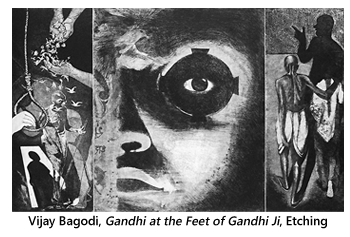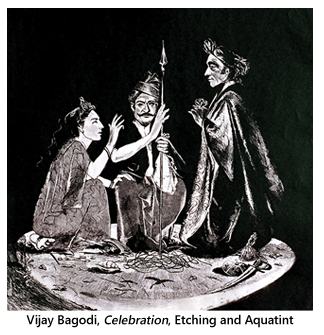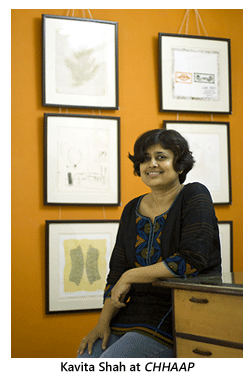- Publisher's Note
- Editorial
- Sixteen printmakers talk about their work
- The Imprinted Body
- A Chai with Vijay Bagodi
- The Wood Engravings of Haren Das
- A Physical Perception of Matter
- Feminine Worlds
- A Rich Theater of Visuality
- A Medley of Tradition
- Decontextualizing Reality
- Printmaking and/as the New Media
- Conversations with Woodcut
- Persistence of Anomaly
- Sakti Burman - In Paris with Love
- Lalu Prasad Shaw: The Journey Man
- Future Calculus
- A Note on Prints, Reproductions and Editions
- A Basic Glossary of Print Media
- The Art of Dissent: Ming Loyalist Art
- Vishnu: Hinduism's Blue-Skinned Savior at the Brooklyn Museum of Art
- Twelfth edition of Toronto International Art Fair
- Vintage Photographs of the Maharajas
- Göteborg International Biennial
- A Museum, a Retrospect & a Centenary for K.K. Hebbar:
- Recent and Retrospective: Showcase of Shuvaprasanna's Work
- "I Don't Paint To Live, I Live To Paint": Willem de Kooning
- Salvador Dali Retrospective: I am Delirious, Therefore I am
- To Be Just and To Be Fair
- Census of Senses: Investigating/Re-Producing Senses?
- Between Worlds: The Chittaprosad Retrospective
- Awesomely Artistic
- Random Strokes
- Counter Forces in The Printmaking Arena and how to Counter them
- Shift in focus in the Indian Art Market
- What Happened and What's Forthcoming
- Art Bengaluru
- Mumbai Art Sighting
- Musings from Chennai
- Art Events Kolkata
- Previews
- In the News
ART news & views
A Chai with Vijay Bagodi
Volume: 4 Issue No: 21 Month: 10 Year: 2011
Feature
Catching up with a quietly busy artist
by Sandhya Bordwekar
Playing hide and seek in incessant rain is hardly a pleasant exercise. I needed to seek out printmaker Vijay Bagodi in a hurry but he would be hiding: taking a class at the Graphics Department at the Faculty of Fine Arts where he teaches, or holed up at Ravi Engineering Works trouble-shooting a printmaking press that has developed some fault and needs to be set right. It is 24 hours before I manage to catch him between classes. And it is even tougher to make him talk!
Over the last many years Bagodi has produced innumerable prints. As a practitioner of printmaking he has generally been pushed into a dark corner in the world of Indian contemporary art, something extremely unfortunate considering the fact that he is one of the few printmakers in India (perhaps with the exception of Anupam Sud) who practices very little other art except printmaking. His personal favourite is etching, followed closely by woodcuts, lithographs, serigraphs and monoprints. Bagodi has been so devoted to printmaking that he has been making and exhibiting prints consistently for the last 30 years. His work has been well received and exhibited in almost all the important international print biennales and triennales in places such as Bangkok, Sarcelles (France), Bangladesh, Taiwan, Slovenia, the USA, Germany, Hungary, and so on. He was also invited to participate in Kaleidoscope, an exhibition of contemporary South Asian and Indian artists at Square One Gallery, New York, in 2004.
Germany, Hungary, and so on. He was also invited to participate in Kaleidoscope, an exhibition of contemporary South Asian and Indian artists at Square One Gallery, New York, in 2004.
Born and brought up in Gulbarga, Karnataka, Bagodi's interest in drawing and painting was triggered by watching his mother make 'crafty' items for the family and decorating the home porch with complex 'rangoli' patterns. So very naturally, after he grew up, he went to Gulbarga's art school to study painting, and finally came to Baroda. There he continued to study painting but was more interested in drawing. But when he opted for printmaking as an optional subject it opened completely new horizons for the young artist. Bagodi went on to specialize in printmaking. “Teachers like Jyotibhai Bhatt, Dhumal, Rini, V. S. Patel always supported and encouraged me,” he explains over a glass of chai. “Printmaking strengthens the drawing hand and develops an excellent visual sense and these skills are invaluable to all students of the fine arts.”
Vijay was a student at Baroda in the late 1970s and early 1980s. “At that time there was a lot of vigorous activity in printmaking. The challenges of the medium, understanding the technology and manipulating it to get the results one wanted; this was all very exciting. A lot of senior artists were experimenting with prints. I got drawn in too, and have never got out!” During that time the British Council staged an exhibition of David Hockney's prints (the "Fairy Tales" series) in Baroda. Seeing that exhibition was a major turning point in Bagodi's ultimate decision to become a full-fledged printmaker. “I gave up painting then. I only did colour pastel drawings if the mood caught me. Otherwise it was just prints,” smiles Bagodi. The colour pastel drawings were made at CAVA, Mysore, where Bagodi taught from 1986 to 1991, “That was because CAVA did not have a graphics department and I had to teach painting” he says. Vijay even put together a couple of shows of these pastel drawings. But when he returned to Baroda in 1991 he plunged straight back into printmaking. His early influence was Laxma Goud. “I was fascinated by the way he worked on the etching plate,” he says, ”the way he worked the edges almost as if the plate was a piece of metal sculpture.”
Bagodi's early prints explored the personal spaces he inhabited and built esoteric narratives of desire and disappointment, love and longing, pain and joy. The erotic was expressed with uninhibited passion, perhaps a lingering of Laxma Goud's influence. It was around the early 1990s, in wake of the Babri Masjid demolition and the communal violence and bomb blasts that followed, that Bagodi's content began to shift to socio-political issues, and he tackled topics such as deprivation, disasters, violence, disharmony, inequality, displacement, and the stress and tension of living in urban India. His prints became peopled with images of men,  women and children caught in the tangled maze of their complicated lives. “It gave my work a concrete direction, I think.”
women and children caught in the tangled maze of their complicated lives. “It gave my work a concrete direction, I think.”
Vijay Bagodi's prints have been included in numerous group shows across the world. One of his prints bagged the National Award in the 40th National Exhibition of Contemporary Art in 1997; another print was also declared Best Print of the Year in the 71st AIFACS Annual Exhibition of Graphic Arts in 2000 and yet another print received an Honourable Mention Certificate at the 5th Bharat Bhavan International Biennale of Print Art in 2001. In 2002, Bagodi was invited to the Khoj International Workshop and Seminar, where, for the first time, he experimented with creating an assemblage artwork that was sculptural in its conception. Though this experience was rewarding, it was still not strong enough to lure Bagodi away from printmaking.
“One of my most wonderful experiences as a printmaker has been when I was working at the Dhumals' printmaking studio in the late 1990s. I assisted the late Bhupen Khakhar, making plates and taking prints for his project, Phoren Soap, the printmaker's book. I really like the works of Bhupen Khakhar. He was a man of wide interests. He did not try to intellectualize life, but cracked jokes and was plain speaking. I also like his works because he projected life around us, the common things; he didn't elevate the simple facts.”
Very aware of the struggle that young printmakers face when bereft of adequate studio/workshop facilities, he became one of the founders of CHHAAP, a printmaking studio initiated by printmaker Kavita Shah with the support of several artists in Baroda. CHHAAP offers space, facilities and residencies, and draws not only Indians but international printmakers to Baroda. “Printmaking, as a medium, has undergone the most astounding changes in the last few years, with digital technology stepping in,” Bagodi says. “New Media, as it is known, has opened so many avenues as well as brought with it numerous challenges too. Dealing with them is both exciting and fatiguing. Now I am more in a state of mind where I love playing with the medium; and enjoying the process. Teaching allows me to engage with young minds, see things in a fresh light. It makes it easier to deal with change.”
CHHAAP
The CHHAAP Baroda Printmaking Workshop was established with much fanfare in 1999 under the leadership of printmaker Kavita Shah and the support of artists such as Gulammohammed Sheikh, Jyoti Bhatt, Vijay Bagodi and others. The workshop was centrally located in Baroda in a sprawling property that belonged to Kavita's family. A number of Baroda artists supported CHHAAP as an enterprise that would offer working opportunities to printmakers interested in making prints but could not because of lack of facilities. In fact, a number of senior artist-printmakers got together to contribute prints towards CHHAAP's first portfolio as a fund-raiser for the workshop. Subsequently, CHHAAP has produced three portfolios as well as organized three projects (Footprint, Ganjifa and Baroda Walk) in the process of which three more portfolios were produced. CHHAAP is currently working on its seventh portfolio which will feature three Indian and three international  printmakers.
printmakers.
In the initial years, CHHAAP was not too active since expenses were high, causing the fees to often be unaffordable for artists, especially the younger ones just out of college. The workshop's entrepreneurial initiatives were also rather conservative, with nobody really looking after it on a fulltime basis when it needed nurturance the most. There can be many reasons that can be cited to defend this, yet if the bottom line is what matters, then very few would deny that in the early days CHHAAP was languishing in making an impression.
CHHAAP has revamped itself in an amazing way in the last few years. Kavita Shah has become much more active and involved in her networking with other printmakers, travelling to printmakers' meets (such as IMPACT) all over the globe, and improving the infrastructure and facilities at the workshop itself. The workshop is now formalized as a registered organization, renamed CHHAAP Foundation for Printmaking Trust with Gulammohammed Sheikh, Vijay Bagodi, Kavita Shah and her husband, Atul Garg, as the honorary founder-trustees. There is an advisory board comprising Vasudevan Akkitham, B. V. Suresh, Archana Hande and Atul Garg that manages decisions regarding exhibitions, artist residencies and workshops. It has a modest website too (www.chhaap.com) that offers all practical and essential information.
In 2005,  CHHAAP re-located to an independent bungalow very close to Kavita's home. It now houses modern facilities for the making of etchings, drypoints, linocuts, woodcuts and monoprints. It also offers a residency programme (between 1-3 months) for printmakers from India and abroad with a self-contained studio apartment on the top floor of the bungalow itself that can accommodate two artists at a time. These resident printmakers are required to work in the studios, hopefully even conduct a workshop in their specialty, deliver one public lecture, interact with students/teachers of the local art school, and have an open house/exhibition of the work created at the end of their residency.
CHHAAP re-located to an independent bungalow very close to Kavita's home. It now houses modern facilities for the making of etchings, drypoints, linocuts, woodcuts and monoprints. It also offers a residency programme (between 1-3 months) for printmakers from India and abroad with a self-contained studio apartment on the top floor of the bungalow itself that can accommodate two artists at a time. These resident printmakers are required to work in the studios, hopefully even conduct a workshop in their specialty, deliver one public lecture, interact with students/teachers of the local art school, and have an open house/exhibition of the work created at the end of their residency.
International resident-printmakers at CHHAAP have so far been Teresa Cole (New Orleans, USA), Catherine Bebout (Fulbright Scholar, Montclaire University, USA), Genevieve Browne (UK), Leila Goddard (New Zealand), Elizabeth Myhill (UK), Johannes Gerard (Holland), and Amy Smith (Australia). They have had interactions with Baroda printmakers and presented their own work and talked about it. Thus CHHAAP has been able to facilitate a very important bridge between printmakers of Baroda and those from different corners of the world. CHHAAP has also introduced outreach programmes especially with educational institutions such as high schools, schools of architecture and interior design and so on, where their associate printmakers deliver hands-on demonstrative workshops to art teachers and students. It is a way to familiarize people with prints, what they are, how they are produced, and most importantly, why they should be valued as a legitimate fine art. CHHAAP is also exploring new platforms for display and exhibitions. One of their recent public shows was held in an ice cream parlour. The group is also forging relationships with organizations like the Alliance Francaise to share exhibition space. CHHAAP's last major print show, Ganjifa, curated by Kavita Shah, brought together 54 printmakers from all over the world, each one creating one 'card' from a pack of 54 regular playing cards (including two jokers). The finished portfolio travelled on exhibition to different parts of India.